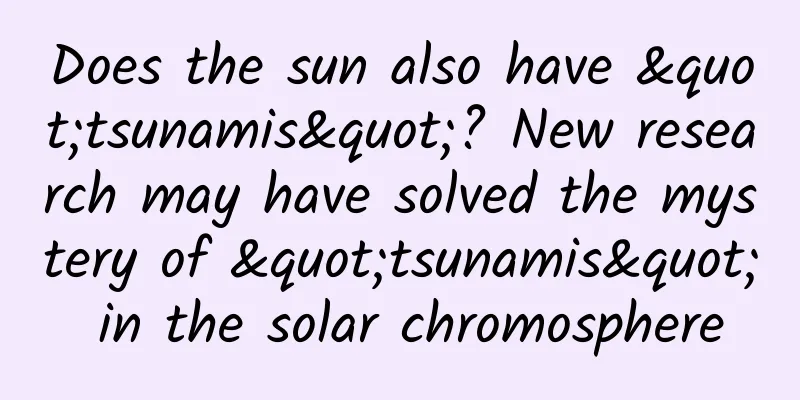Does the sun also have "tsunamis"? New research may have solved the mystery of "tsunamis" in the solar chromosphere

|
There is such a horrifying scene in the Chinese science fiction film "The Wandering Earth": due to the Earth's cessation of rotation, the sea level in the Shanghai area will rise by 300 meters, and a large number of coastal areas around the world will be engulfed by tsunamis! It can be seen how vulnerable humans are in the face of tsunamis. As one of the most extensive explosive natural disasters on Earth, the wave speed of a tsunami is as high as 800 kilometers per hour and can spread for thousands of kilometers. Tsunamis are mainly caused by submarine earthquakes, volcanic eruptions, submarine landslides and other activities. This kind of violent explosive activity not only occurs on Earth, but also often occurs on the Sun, such as coronal mass ejections and flares. These explosive activities can also trigger "solar tsunamis" with higher energy and larger scale. Figure 1: Earth tsunami (Source: Internet) The “ sea” of “ solar tsunami ” "Solar tsunami" is a wave phenomenon that propagates in the solar atmosphere, so the solar atmosphere can be regarded as the propagation medium of this wave - "solar sea". Just like the terrestrial tsunami, the solar atmosphere determines the nature of the "solar tsunami" to a large extent. The sun continuously generates energy through nuclear fusion in the core area, and then this energy passes outward through the radiation zone and reaches the outer solar atmosphere. The solar atmosphere can be divided into the photosphere, chromosphere, transition zone and corona from the inside to the outside, which are full of plasma or ionized gas. The photosphere is the sun's luminous disk visible to the naked eye, with a thickness of about 500 kilometers; above the photosphere is the chromosphere with a thickness of about 2000 kilometers and the transition zone with a thickness of about 100 kilometers; beyond the transition zone is the corona, which can extend all the way to interplanetary space. The temperature of the photosphere is about 5000 degrees, the temperature of the chromosphere ranges from 4000 to 20000 degrees, and the temperature of the corona is as high as millions of degrees. The plasma density in the solar atmosphere drops sharply in the photosphere, chromosphere and transition zone, and drops slowly in the corona. In addition, the solar atmosphere is full of magnetic fields, which are generated from the interior of the sun and constantly emerge in the atmosphere above, ultimately affecting or even controlling the activities in the solar atmosphere. Figure 2: "Sun Sea" (Source: Wikipedia) Any disturbance will produce fluctuations. Disturbances in the Earth's atmosphere can produce sound waves, and seismic waves are also a type of sound wave. In the solar atmosphere, disturbances mainly excite magnetoacoustic waves, which are produced by the coupling of sound waves and magnetic field fluctuations (a type of fluctuation caused by the shaking of magnetic field lines, called Alfvén waves). The speed of these magnetoacoustic waves can range from one or two hundred kilometers per second to thousands of kilometers per second. Discovery of " solar tsunamis " "Solar tsunami" is a circular wave front that propagates in all directions from the explosion source in the solar atmosphere. Because its radiation enhancement is mainly concentrated in the extreme ultraviolet band, it is also called coronal extreme ultraviolet (EUV) wave. In addition, since it was first observed by the Extreme Ultraviolet Imaging Telescope (EIT) on the Solar and Heliospheric Observatory (SOHO) satellite launched in 1995, its earliest name was coronal EIT wave. The first "solar tsunami" was detected by EIT in 1997, but its existence was predicted more than 20 years ago. Figure 3: "Solar tsunami". (Source: NASA/STEREO) Long before the launch of solar observation satellites, astronomers mainly relied on ground-based telescopes to observe the sun. In the early 1960s, American astronomer Gail Moreton observed the "tsunami" phenomenon occurring in the solar chromosphere. The figure below shows an example. This wave is relatively weak, but its speed is thousands of kilometers per second, and it can propagate almost globally on the solar surface. Later generations called this "chromospheric tsunami" Moreton wave. Figure 4: “Chromosphere tsunami” (Source: National Solar Observatory and U.S. Naval Research Laboratory) Are such fast Moulton waves generated in the chromosphere? Considering that the chromospheric Alfvén velocity (about 100 kilometers per second) is relatively small, the high-speed chromospheric magnetoacoustic waves of 1000 kilometers per second can only be very strong shock waves (Mach number is about 10). However, such strong shock waves should decay quickly and have a short propagation distance, which is inconsistent with observations. In order to solve this problem, in 1968, Japanese astronomer Yutaka Uchida proposed that Moulton waves are the "footprints" left by the rapid shock waves propagating in the corona and compressing the chromosphere downward. In this way, the speed of Moulton waves is determined by the speed of magnetoacoustic waves in the corona, not the speed of magnetoacoustic waves in the chromosphere. This theory can explain many observational characteristics of Moulton waves, and at the same time, like many scientific theories, it also makes a prediction: there is a "tsunami" in the corona! Since the corona radiation band is mostly concentrated in the extreme ultraviolet (EUV) or soft X-ray band, and these radiations cannot pass through the atmosphere to reach the ground, therefore, in order to verify this prediction, it is necessary to launch a solar observation satellite into the sky. This goes back to the discovery of EUV waves or EIT waves introduced earlier. A rare "chromospheric tsunami" - the Moulton wave Since their discovery, only dozens of Moulton waves have been observed. However, since the launch of multiple solar satellites, thousands of "solar tsunamis" have been observed. So the question is, since "solar tsunamis" are the source of Moulton waves, why do so many "solar tsunamis" produce only so few "chromospheric tsunamis"? In other words, why are Moulton waves so rare? Recently, Professor Zheng Ruisheng and Professor Chen Yao from the Institute of Space Science of Shandong University and their collaborators (including Professor Chen Pengfei from Nanjing University and Professor Tian Hui from Peking University) published a paper in the international academic journal Astrophysical Research Letters, providing key evidence for solving the rare mysteries of "solar tsunamis" and "chromospheric tsunamis". The study found that for the coronal EUV waves accompanied by Moulton waves, there is a sharp and bright area at the bottom of the wavefront, and there is also a similar wave response on the 304 angstrom spectral line originating from the intermediate region between the corona and the chromosphere, the so-called transition region; more surprisingly, such events are all caused by oblique explosions. Therefore, it is proposed that one of the most critical factors for the "solar tsunami" to successfully excite the "chromospheric tsunami" is the highly inclined (about 70 degrees away from the radial) configuration of the explosion. The highly inclined "solar tsunami" wavefront can more strongly compress the lower atmosphere of the sun and thus excite the "chromospheric tsunami", and the infrequent or "rare" occurrence of highly inclined explosions is likely to be the key reason for the rarity of "chromospheric tsunamis" that astronomers have been looking for for a long time! This study is of great significance for a comprehensive understanding of the excitation mechanism and three-dimensional propagation of "solar tsunamis", and can also indirectly reveal the triggering mechanism of oblique explosions and the acceleration mechanism of high-energy particles, thereby providing important information for space weather forecasting. Figure 5: "Solar tsunami" in oblique eruption (Source: Zheng et al. ApJL, 2023) This article is a work supported by Science Popularization China Starry Sky Project Author: Zheng Ruisheng Reviewer: Han Wenbiao, Researcher at Shanghai Astronomical Observatory, Chinese Academy of Sciences Produced by: China Association for Science and Technology Department of Science Popularization Producer: China Science and Technology Press Co., Ltd., Beijing Zhongke Xinghe Culture Media Co., Ltd. |
<<: Exploring the "Euclid" of the Dark Universe
Recommend
10 community operation experiences gained in 365 days with RMB 150,000!
Real cases and diligent exploration of community o...
A new perspective on the four winning marketing rules
To design a successful home delivery activity pla...
Chinese Music General Education Course by Chinese Music Artist Fang Jinlong
Introduction to the resources of the Chinese Musi...
After meeting many buyers in the past six years, can the Hammer smartphone revive?
After Luo Yonghao gave up his legal representativ...
JD’s advertising copy is heartbreaking!
JD.com shot a new advertisement Offended all the ...
Mount Emei, the other side you don’t know
Mount Emei is one of the four famous Buddhist mou...
Analysis of the leading players in live streaming e-commerce: Douyin, Kuaishou and Taobao!
01. Live streaming e-commerce, is it e-commerce o...
Kaikeba Enterprise-level Task-based Dialogue Robot [4,5,6]
Kaikeba Enterprise-level Task-based Dialogue Robo...
Why domestic browser kernels stop at Chromium 32
As of May 11, 2014, the official stable version of...
The copywriting for 520 Confession Day is here, it’s a little sweet!
520 is coming Your love's call Emm...it shoul...
China Association of Automobile Manufacturers: A brief analysis of the sales of the top ten MPV manufacturers from January to May 2022
According to statistics and analysis of China'...
What is the "dark" candied haws? Take a look at China's "first string" of candied haws!
Winter is coming The best season to eat candied h...
Why do all the unearthed Terracotta Warriors have single eyelids? It may be due to these two reasons →
A reporter recently learned from the Qin Shihuang...
Samsung Note7 "fully revived" refurbished and available for sale, but not in China
2016 was a year of great changes for the entire m...
Zhihu ranking algorithm and traffic diversion method
The following content is the editor’s exclusive e...









